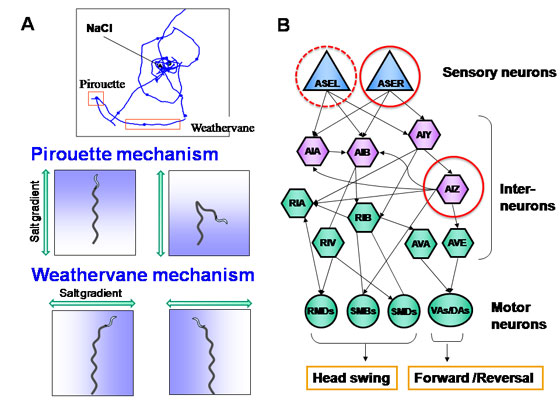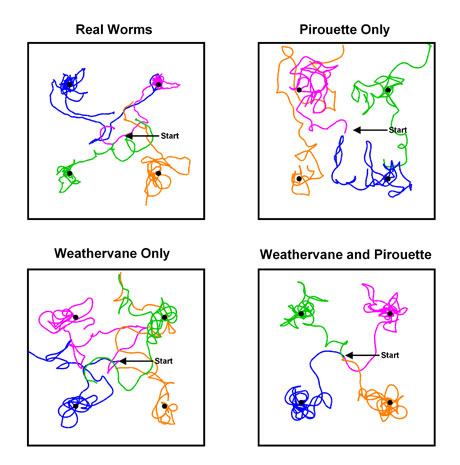Worms reach the destination using two behavioral patterns
Animals receive various sensory inputs and respond to it to maximize the probability of achieving its goals, for example survival. The nematode C. elegans has only 300 neurons and using the small neural circuit approach its food by sensing the taste and odor. The behavior in which worms are attracted to chemicals is called chemotaxis. We analyzed the behavioral strategy of C. elegans to reach the chemicals by using a worm tracking system. Although the behavior is highly variable, quantification of the behavior revealed that worms show two different responses to chemicals. To the chemical gradient in the direction of locomotion, they show pirouette response, and to the gradient perpendicular to the gradient they show weathervane response. Computer simulation shows that either of these mechanisms alone cannot generate efficient chemotaxis, but combination of the two causes chemotaxis as good as real worms. In search for neurons that are important for these behaviors, laser ablation experiments were performed and two classes of neurons, ASER and AIZ were shown to be essential for chemotaxis to NaCl. AIZ seems to send outputs to both neurons for reversal and those for curving.
Program member
Yuichi Iino (Department of Biophysics and Biochemistry, Graduate School of Science)

Figure 1. A: Schematic representation of the pirouette mechanism and the weathervane mechanism. When worms encounter chemical gradient in the direction of locomotion, they backup and quickly switches the direction of locomotion (pirouette mechanism). When there is a gradient in the direction perpendicular to locomotion, worms gradually curve towards higher concentration of the chemical (weathervane mechanism). B: Laser ablation experiments show that neurons in circles are essential for both pirouette and weathervane mechanisms. Killing neither of AIA, AIB, AIY, RIA nor RIZ caused discernible effect on chemotaxis.

Figure 2. Results of computer simulation. Either pirouette or weathervane mechanism alone is insufficient for good chemotaxis. With both mechanisms, worms can reach the chemical as efficiently as real worms.
